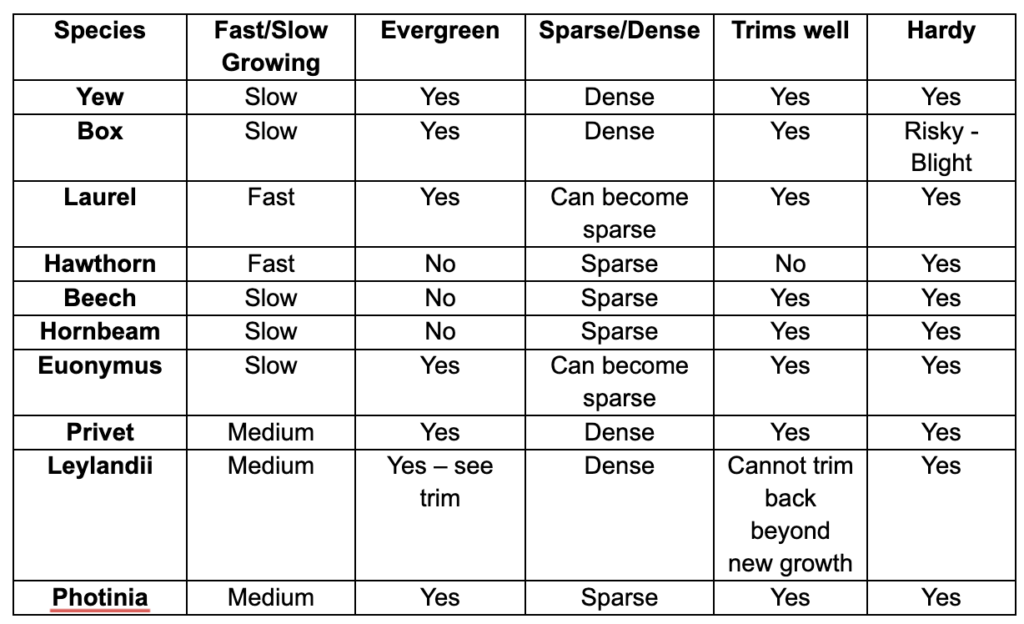Hedges can provide privacy, structure and partitions, and promote wildlife habitats in a garden. With many different species of hedging to choose from, where do you start, and what do you need to keep in mind when planning, planting, and creating a hedge?
In the past, the Leylandii hedge was often cited as a major cause of neighbourly disputes. A popular option for housing developers in the 1970s and 80s, Leylandii grew fast and dense but blocked out light, look unsightly when clipped too hard and suck nutrients out of the ground for some distance. Today, there are more species available to create hedging – and a greater understanding of picking the right plant for the job.
We work with lots of landscaping and garden design specialists and have asked our colleagues and contacts for their ideas and tips on how to grow a hedge. Here are their top tips:
What’s the hedge for?
First and foremost, you need to be clear what purpose the hedge will have. This will determine which species you require and the speed of growth. For instance, if you’re keen for privacy, a box hedge will take too long to grow to a height that provides any form of screening to windows or the garden behind.
Key reasons for growing a hedge include:
Privacy – hedges offer a gentle method of creating privacy where it may not be possible or appropriate to use a wall or fence. Most hedge plants are supplied in whips or young plants of around 1m in height or a couple of years old.
If you’re planting a hedge for privacy, you’ll need to invest in larger specimens, which is not possible for all varieties, or be more patient. If privacy is most important you’ll need to discount many slow-growing deciduous plants like Box, Euonymus, Photinia and Yew. You’ll also want to avoid plants that don’t offer a dense structure unless you’re happy to obscure the view. A well-prepared laurel hedge planted with 1m specimens will take up to 5 years to achieve a dense 1.8m tall hedge. With a 1m root ball laurel costing around £10-£15 and a recommended planting distance of 1m – 1.5m, then the cost comparison to a 1.8m close-boarded fence over the same distance may make the wait worth it!
Border/partition/boundary – if you want to delineate areas of the garden, a hedge is a wonderful option. Fences offer quite a hard boundary and whilst they can be softened with climbers and surrounding planting, they also need more maintenance than hedges and tend to cost more initially.
If you’re creating a border or partition, and time is on your side then there will be more options available for which plants to use for your hedge, including slow-growing varieties like Yew and Beech. Depending on the size of your garden, you may want to create something that allows the light to flow through it or which offers glimpses beyond into another part of the garden. Equally, you may not need a tall hedge and may not be as concerned about the plants losing their foliage in the winter.
If you’re on a road and want to mark your boundaries, planning permission may not be possible for a fence or wall close to the road and so in these instances, a hedge will be more acceptable. You may also have planning restrictions stopping you from erecting a hard boundary if parts of your land are designated ‘aesthetic amenity’ land. Hedges don’t fall under the same restrictions; in a bizarre twist a 6-foot high, dead straight hedge is allowed where a 6-foot-high dead straight fence (made of wood!) isn’t!
Protection – hedges can be used to provide protection too. If you’re in an exposed part of the country with winds whistling across the garden, then a hedge can function as a useful windbreak. They can also be used to create shade for very sunny gardens to protect tender plants, veg plots or seating areas from the extremes of the summer sun.
If you’re planting a hedge for protection then even a deciduous, or slightly more sparse variety may work because it will still act as a filter. If you’re trying to provide protection from the wind, then a thick dense hedge may act like more of a sail, disturbing the roots of the hedge plants or risking it being blown over. So, a beech, hornbeam or hawthorn hedge may work just as well to dissipate the wind or the sun rather than attempt to block it entirely.

How long does it take to grow a hedge?
How long a hedge takes to become fully established depends on the species, the quality of the soil and the weather. A dense laurel will take around 5 years to reach 1.8 m tall, whereas a box hedge could take up to 20 years to achieve 1.5m height.
When buying plants, if there’s an option to pay more and buy bigger specimens or choose root balls over bare roots, then opt for established plants. Anything that needs to set root or is still tender may result in some false starts or replacements along the line. This may then mean you have parts of the hedge growing at different phases/speeds.
Which trees, shrubs or plants should I use for my hedge?
Choose your variety of plant carefully to ensure you pick a species that will deliver its purpose with the correct height and density. Common options include:

When should I plant my hedge?
Most shrubs, trees and plants used to create hedges will have a dormant period, likely to be the winter or early autumn, which will be the best time to plant. They’ll flourish in the spring and summer. If you’re planting later in the year, around summer or autumn, you may need to stake tall stems against wind and ensure plenty of water around the roots whilst they become established.

Hedge growing tips
Here are some quick hedge-growing tips to help ensure you grow a healthy and successful hedge:
Prepare the soil – if you have sandy or heavy clay soil, you can mix with Tree and Shrub Topsoil to give the soil a mix of natural organic nutrients and humus.
Double dig! – hedges need to develop their roots so plant them in good quality, double-dug soil. Double digging refers to two spades’ height, so once you’ve broken the surface, you need to dig down another spade’s depth. The deeper you dig and the looser the earth around the root ball, the faster the plants will establish.
Allow space for growth – it’s not uncommon for hedging to be planted too close together to try and create the eventual line from day one. But if you consider a Photinia or Laurel will need up to 1m diameter when fully grown, you may end up overcrowding and the plants will struggle. Box hedges will look a bit odd at first, but within a year or two the gaps will shrink. Refer to plant labels for width and height when planning your planting. If you’re growing alongside a driveway or path and don’t want to spend your life trimming it, make sure you set the plants back the correct distance too!
Avoid cutting for the first couple of years – it may be hard to do, because you feel you want to control the growth, but try and avoid cutting your plants for a few years. As a rule of thumb, if you’re keen for height, allow vertical shoots to go and only begin cutting them when they are around 30-50 cm above your desired finished height. This will encourage them to push outside shoots to establish height and then density.
Water well – ensure the shrubs are well watered during the dry seasons for the first two years of growth.
Earth Cycle
Thanks to our fellow landscapers and garden designers for all their valuable hedge-growing tips! We wish you luck with your hedge growing and please do let us know how you get on, we would love to hear from you!
If you need the right compost, topsoil and gardening tools to get your hedge growing, then Earth Cycle has everything you need in one place. We offer free delivery across the UK, so no matter where you want your hedge grown, we can deliver it!




